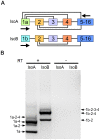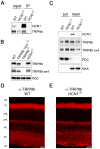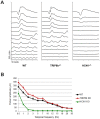TRIP8b is required for maximal expression of HCN1 in the mouse retina
- PMID: 24409334
- PMCID: PMC3883711
- DOI: 10.1371/journal.pone.0085850
TRIP8b is required for maximal expression of HCN1 in the mouse retina
Abstract
Hyperpolarization-activated cyclic nucleotide-gated (HCN) channels are cation-selective channels present in retina, brain and heart. The activity of HCN channels contributes to signal integration, cell excitability and pacemaker activity. HCN1 channels expressed in photoreceptors participate in keeping light responses transient and are required for normal mesopic vision. The subcellular localization of HCN1 varies among cell types. In photoreceptors HCN1 is concentrated in the inner segments while in other retinal neurons, HCN1 is evenly distributed though the cell. This is in contrast to hippocampal neurons where HCN1 is concentrated in a subset of dendrites. A key regulator of HCN1 trafficking and activity is tetratricopeptide repeat-containing Rab8b interacting protein (TRIP8b). Multiple splice isoforms of TRIP8b are expressed throughout the brain and can differentially regulate the surface expression and activity of HCN1. The purpose of the present study was to determine which isoforms of TRIP8b are expressed in the retina and to test if loss of TRIP8b alters HCN1 expression or trafficking. We found that TRIP8b colocalizes with HCN1 in multiple retina neurons and all major splice isoforms of TRIP8b are expressed in the retina. Photoreceptors express three different isoforms. In TRIP8b knockout mice, the ability of HCN1 to traffic to the surface of retinal neurons is unaffected. However, there is a large decrease in the total amount of HCN1. We conclude that TRIP8b in the retina is needed to achieve maximal expression of HCN1.
Conflict of interest statement
Figures







Similar articles
-
TRIP8b splice forms act in concert to regulate the localization and expression of HCN1 channels in CA1 pyramidal neurons.Neuron. 2011 May 12;70(3):495-509. doi: 10.1016/j.neuron.2011.03.023. Neuron. 2011. PMID: 21555075 Free PMC article.
-
Alternatively spliced isoforms of TRIP8b differentially control h channel trafficking and function.J Neurosci. 2009 May 13;29(19):6250-65. doi: 10.1523/JNEUROSCI.0856-09.2009. J Neurosci. 2009. PMID: 19439603 Free PMC article.
-
Trafficking and gating of hyperpolarization-activated cyclic nucleotide-gated channels are regulated by interaction with tetratricopeptide repeat-containing Rab8b-interacting protein (TRIP8b) and cyclic AMP at distinct sites.J Biol Chem. 2011 Jun 10;286(23):20823-34. doi: 10.1074/jbc.M111.236125. Epub 2011 Apr 19. J Biol Chem. 2011. PMID: 21504900 Free PMC article.
-
The structure and function of TRIP8b, an auxiliary subunit of hyperpolarization-activated cyclic-nucleotide gated channels.Channels (Austin). 2020 Dec;14(1):110-122. doi: 10.1080/19336950.2020.1740501. Channels (Austin). 2020. PMID: 32189562 Free PMC article. Review.
-
Neurophysiology of HCN channels: from cellular functions to multiple regulations.Prog Neurobiol. 2014 Jan;112:1-23. doi: 10.1016/j.pneurobio.2013.10.001. Epub 2013 Oct 29. Prog Neurobiol. 2014. PMID: 24184323 Review.
Cited by
-
Identification of a VxP Targeting Signal in the Flagellar Na+ /K+ -ATPase.Traffic. 2015 Dec;16(12):1239-53. doi: 10.1111/tra.12332. Epub 2015 Oct 13. Traffic. 2015. PMID: 26373354 Free PMC article.
-
Differential impact of Kv8.2 loss on rod and cone signaling and degeneration.Hum Mol Genet. 2022 Mar 31;31(7):1035-1050. doi: 10.1093/hmg/ddab301. Hum Mol Genet. 2022. PMID: 34652420 Free PMC article.
-
Identification of HCN1 as a 14-3-3 client.PLoS One. 2022 Jun 9;17(6):e0268335. doi: 10.1371/journal.pone.0268335. eCollection 2022. PLoS One. 2022. PMID: 35679272 Free PMC article.
-
Morphological and physiological analysis of type-5 and other bipolar cells in the Mouse Retina.Neuroscience. 2016 Feb 19;315:246-58. doi: 10.1016/j.neuroscience.2015.12.016. Epub 2015 Dec 15. Neuroscience. 2016. PMID: 26704635 Free PMC article.
-
A di-arginine ER retention signal regulates trafficking of HCN1 channels from the early secretory pathway to the plasma membrane.Cell Mol Life Sci. 2015 Feb;72(4):833-43. doi: 10.1007/s00018-014-1705-1. Epub 2014 Aug 21. Cell Mol Life Sci. 2015. PMID: 25142030 Free PMC article.
References
-
- Fain GL, Quandt FN, Bastian BL, Gerschenfeld HM (1978) Contribution of a caesium-sensitive conductance increase to the rod photoresponse. Nature 272: 466–469. - PubMed
-
- Knop GC, Seeliger MW, Thiel F, Mataruga A, Kaupp UB, et al. (2008) Light responses in the mouse retina are prolonged upon targeted deletion of the HCN1 channel gene. Eur J Neurosci 28: 2221–2230. - PubMed
-
- Seeliger MW, Brombas A, Weiler R, Humphries P, Knop G, et al. (2011) Modulation of rod photoreceptor output by HCN1 channels is essential for regular mesopic cone vision. Nat Commun 2: 532. - PubMed
Publication types
MeSH terms
Substances
Grants and funding
LinkOut - more resources
Full Text Sources
Other Literature Sources
Molecular Biology Databases

